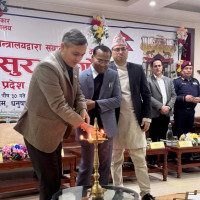- Wednesday, 14 January 2026
Jumbled Tithis upset Tihar calendar this year
Kathmandu, Oct. 23: Yamapanchak began this year on Saturday with Dhanteras. As the ‘Panchak’ in its name suggests, the festival, better known as Tihar, is generally celebrated for five days from the 13th day of the dark fortnight of the Nepali month of Kartik to the second day of the bright fortnight.
However, this Bikram year of 2079 has given Nepalis a confusing six-day Deepawali, one where Kukur Tihar and Laxmi Puja have fallen on the same day but Laxmi Puja and Gai Puja have uncharacteristically not.
This has led to confusion among the public and has misaligned Tihar with its Kathmandu Valley counterpart Swonti.
“Unfortunately, this is what happens with lunar calendars,” said priest Madhav Chalise.
Our occasions are determined by the waxing and waning of the moon – traditionally called Tithis – which do not neatly fit into our midnight-to-midnight 24-hour calculation of days, he explained. “Sometimes, the same Tithi spans multiple calendar days while other times, more than one Tithi falls on the same day.”
Chalise mentioned that such inconsistencies were nothing out of the ordinary. “They happen regularly but we only notice them when they mess with our festivals,” he said.
And messed they have this year. Govardhan Puja and Laxmi Puja do not follow each other, as they usually do, and instead have a gap day between them. As astrologer Bheem Joshi joked, the conniving Tithis have brought Laxmi Puja forward by a day. Laxmi, the goddess of wealth, should be worshipped on Monday this Tihar, Joshi explained, because Laxmi Puja can only be performed on a new moon day.
“The Aunsi (new moon) begins at around 5 pm on Monday and ends at around 4.30 pm on Tuesday.
Since we worship Laxmi in the evening, we must do so on the day that has the Aunsi in the evening (Monday),” he said.
Then, there is the matter of the partial solar eclipse taking place on Tuesday. According to the information the Nepal Calendar Determination Committee (NCDC) provided to the Rastriya Samachar Samiti, the eclipse shall begin at 4.52 pm and last till 7.30 pm, although it will not be visible after the sun sets at 5.24 pm.
“In Hinduism, it is not considered auspicious to worship during eclipses. So, Laxmi Puja got preponed,” priest Chalise said.
Swonti-Tihar misalignment
The other two main days of Tihar – Govardhan Puja and Bhai Tika – are not affected by the eclipse and do not experience the same Tithi trickeries as Laxmi Puja. Hence, they can be celebrated on their usual days, that is, Govardhan Puja on Pratipada and Bhai Tika on Dwitiya, the NCDC’s schedule reveals.
But this means that aside from Gai (cow) Puja in the morning, Tuesday is vacant and this vacancy has caused it to fall out of sync with the Swonti Nakha of the Newa community. “Swonti should be Swonu (meaning three days in Nepal Bhasa) in length. It is perplexing to have an empty day in between,” said 84-year-old Bhakta Ram Kayastha, a resident of Ekantakuna, Lalitpur.
Many social and cultural organisations of the valley have issued statements asking the community to celebrate Swonti continuously from Monday to Thursday, with Laxmi Puja on the first day, Mha Puja on the second day and Kija Puja/Bhai Tika on the third day.
This is no reason to raise eyebrows, astrologer Joshi said. “Since the Pratipada Tithi begins on Tuesday evening after the end of Aunsi, families choosing to do so can have Mha Puja at night once the eclipse ends.”
“This is an issue of our community that should be decided by us,” he believed. “But let us keep in mind the relation Mha Puja has with the beginning of the new Nepal Sambat year,” he urged.
Mha Puja in Nepal Bhasa means self-worship and Newar families across the nation observe this day, which is generally also the first day of Nepal Sambat year, by paying respects to their body and acknowledging the divinity in it.
However, this year, the new Nepal Sambat year 1143 is beginning on Wednesday, a day later than when community organisations have asked people to worship themselves.
This is a recurring problem and one that can only be solved by establishing a central authority to determine the valley’s festivals or by giving legal recognition to the customary institutions that have traditionally fixed calendars in Kathmandu Valley, namely Janabahal in Kathmandu, Kwabahal in Lalitpur and Taleju Maju in Bhaktapur, argued Newa cultural activist Rukshana Kapali in a tweet posted on Friday.
Animal worship
Although not the case this year as mentioned above, Tihar is celebrated for five days, of which, the first four days are marked worshipping of crows, dogs, cows and oxen respectively.
The first day is dedicated to crows and hence, is called Kaag (Crow) Tihar. Priest Harihar Mishra informed that crows were believed to bring messages from Yamaraj, the god of death, and appeasing them through prayers and food would ward off death and grief.
People also mark the day as Dhan Trayodashi and buy gold and silver and many also worship Dhanwantari, the Hindu god of medicine, he shared.
Similarly, people worship dogs on the second day named Kukur (Dog) Tihar. Mishra said that this was a celebration of the sacred bond present between man and dog, as exemplified in the epic Mahabharat by Yudhisthir’s refusal to enter heaven without his canine companion.
He added that this was also to worship dogs as the gatekeepers of hell (Narak), which is why this day is also known as Narak Chaturdashi. “Yama is believed to have two four-eyed guard dogs who watch over the gates of hell,” he said.
On this day, the security agencies also worship their doggo officers.
The third day is Gai (Cow) Tihar where cows are worshipped for their service to humans and as representations of Laxmi. This is also a day to thank them for their milk, which can be used to prepare a host of nutritious food items,
their urine, which supposedly has health benefits, and their dung, which can be used as fuel, fertiliser or to purify houses, Mishra elucidated.
On the fourth day, the ox is worshipped because it has an important role in agriculture, he said.
Saag Tihar
Saag (Leafy greens) Tihar is a unique custom present in the Kavrepalanchowk district. According to Bal Krishna Kafle, 83, who is a local of the district, it is an occasion marked a day before Kaag Tihar by people seeking to gamble.
“It was an occasion people made up to invent a day for gambling,” he told The Rising Nepal. “Saag Tihar provided people an opportunity to gamble, which used to be tightly regulated during the Rana and Panchayat years, under the banner of Tihar.”
Saag Tihar still remains in the vocabulary of Kavre-ites, although, this association seems to have faded.







-square-thumb.jpg)






